How design thinking can enhance digital transformation

How design thinking can enhance digital transformation
November 11, 2022
Digital transformation can hardly succeed without a key ingredient – design thinking. This iterative approach is more than just a process. It is a wholly new way to think. A mindset.
But wait a minute… In this article, we will get straight to the point and tell you what design thinking is and why so many companies are thinking big and investing in human-centric design.
What is design thinking?
In 2009, Airbnb was on verge of bankruptcy. Back then, the company’s revenue hardly touched US$ 200 a week. Today, it is revolutionizing its sector. The key to the platform’s success? The big game-changer was design thinking.
Here are three things design thinking is not about: It is not merely about design. It is not about which colours or fonts will work best. And it is not exclusive to designers as it can be implemented in several fields.
The mindset behind design thinking advocates that one must adopt a designer’s mindset and approach the problem from the user’s perspective to come up with innovative solutions. This methodology values user experience above everything else and redefines problems in human-centred ways to build better, more refined solutions. Creativity, logic, and analysis are design thinkers’ best friends.
If we think about it, there is a brand that stands as the epitome of this philosophy. Apple has impressed consumers with some amazing cutting-edge features over the years, from touchscreen technology to fingerprint sensors. For instance, iPhone’s internet access, text messaging, and built-in camera paved the way for the standard smartphone.
The 5 phases of design thinking
Design thinking is an iterative and non-linear process that encourages constant experimentation.
There are several variations of the design thinking process in use today. Some have as few as three steps, whereas others have as many as seven. But the most accepted theory defines five phases: Empathize, Define, Ideate, Prototype and Test. You can carry these stages out in parallel, repeat them and circle back to a previous stage at any point in the process.
Empathize: Examining, engaging, and empathizing with people to understand their experiences and motivations. Empathy allows design thinkers to set aside their assumptions.
Define: At this moment, the purpose is to put together and synthesize the information about users you have created from the previous stage and guide the team in the right direction for the next stage.
Ideate: Now, with a clear problem statement in mind, this is the time to start generating ideas, identifying as many potential solutions to the problem as possible.
Prototype: After narrowing the ideas down to a few, you need to turn them into prototypes. This stage’s goal is to make an idea/hypothesis tangible enough to stimulate a response from whomever you are designing for. Based on valuable insight from user experience results, solutions are either accepted, improved or re-examined.
Test: Now, we will test the best solutions identified during the previous stage. The prototypes are evaluated and then iteratively retested to implement several refinements.
If experience is not a priority, you are doing it wrong
Why? Because focusing on the human dimension when envisioning, designing, and developing technology solutions or digital products allows organisations to come up with the best possible outcomes to enhance the customer experience. Give them a superior experience and you will be rewarded with increased loyalty, higher investment, and stronger relationships.
Brands have much to lose if they fail to live up to the expectations of their users or customers. Research from Qualtrics and ServiceNow revealed 80% of customers said they have switched brands because of poor customer experience. Applying design thinking to a business strategy fosters a culture of innovation and adds tremendous value to the company.